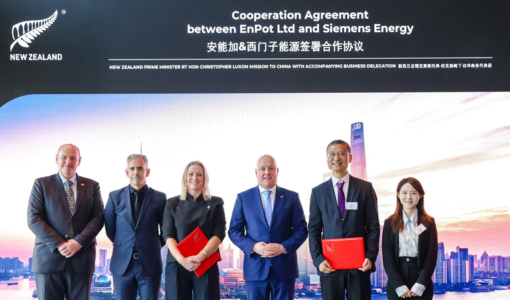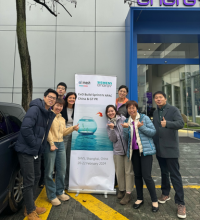Trust the process: lessons from inside a global innovation sprint

10 July 2025
By Cherie Mylordis
What does it take to get a small New Zealand tech company and the Prime Minister of New Zealand on stage in Shanghai with a global energy giant?
No, this isn’t the beginning of a brain-stretching riddle, it’s the truth behind a recent reality. And I can tell you what it took.
It took belief.
It took bold goals.
And it took a robust process.
Because behind the headlines announcing the partnership between Siemens Energy and EnPot (the NZ tech company I mentioned) were months of hard work, a seemingly insurmountable challenge, uncertainty, self-doubt, trial and error, and triumph.
An audacious goal
Watching from Australia as my Siemens Energy colleagues joined representatives from EnPot and the NZ Prime Minister on a stage in China, I was filled with pride.
Why? Let’s rewind to March 2025.
Siemens Energy China brought together select professionals from across its immense team to take part in a global ExO Sprint, and I was one of the coaches hired to facilitate. Our mission felt overwhelming: to accelerate the decarbonisation of China’s aluminium industry.
It was a complex goal, and one that other parts of the business had attempted to achieve before, without much success. But while it might have felt impossible, it’s these kinds of stretch goals where a sprint like this can make a huge impact - it means we have a framework, a timeline, and a team of experts who can play to their strengths. I was excited to see where we’d get to, and also a little terrified.
An uncertain beginning
 In week one of the sprint, we met in person in Shanghai.
In week one of the sprint, we met in person in Shanghai.
I was the only native English speaker in a room full of sharp, highly skilled professionals, who all looked a little bewildered. Yue, who was assigned as the team’s translator, turned to me and asked: “Why are we even here?”
She wasn’t being difficult. She was being honest.
What could this team create that hadn’t already been created in other cities and countries? What could they possibly bring to the table?
I remember that feeling vividly. The doubt. The pressure. The enormity of the challenge.
And I remember replying: “Trust the process.”
The messy middle
The early days of the sprint were filled with tension. Some team members were daunted by the time commitment - we were going to be working on this project for 12 months, and they’d have to find time to dedicate to it on top of their full-time jobs.
Others were overwhelmed by the responsibility. What if, after all of this time and effort, we came up with nothing worth pursuing?
Then came the cultural dynamics we had to overcome. Language barriers, unfamiliar frameworks, different norms around hierarchy and collaboration.
There were moments of fatigue, confusion, and even tears. And yet… we kept going.
Not because it was easy. Because we were trusting the process, and it was clear the process was starting to work.
Through structured weekly assignments, feedback loops, and deep coaching, the team began to gel. Ideas started to emerge. Curiosity replaced resistance. Confidence began to build.
Coaching, not control
My role as a coach wasn’t to give them the answers. In fact, I couldn’t.
I wasn’t an expert in aluminium smelting or battery storage. But I was there to hold space, ask questions and nudge the team outside their comfort zones.
In this sprint model, even the CEO and CFO can’t tell teams what to do. Their autonomy is real. And that’s where the magic lies.
You create the right conditions, and then get out of the way.
A game-changing innovation
When the team finally selected their leading idea, AiSpring, a breakthrough in energy modulation for aluminium smelters, it was an idea born from technical expertise and refined through collaboration, research and relentless iteration.
Presenting to their peers and leaders, the judges were unanimous in their approval of the project and selected it as an idea to be invested in.
Months later, that very concept became part of a global cooperation agreement with EnPot, a New Zealand-based company pioneering flexible energy solutions.
And when that agreement was announced on stage in Shanghai, with the Prime Minister of New Zealand standing beside Siemens Energy leadership, all our hard work had paid off. From here, this project will create real change in reducing the amount of carbon produced by aluminium smelting in China - which is home to 55% of the world’s smelters.
Rising to the challenge
This is just one example of how innovation can thrive in the right conditions.
In an age of accelerating challenges such as climate change, economic uncertainty, AI and tech disruption and political upheaval, we don’t have the luxury of waiting for perfect conditions to lead.
Innovation leadership isn’t optional, it’s urgent. And it doesn’t start with big budgets, grand titles or clarity, it starts with trusting the process, because in the messy middle is where real transformation happens.
Are you ready to rise the challenge and explore innovation?
Get in touch and let’s chat.
Enter your email address and name to subscribe to our blog and receive notifications of new posts by email.
